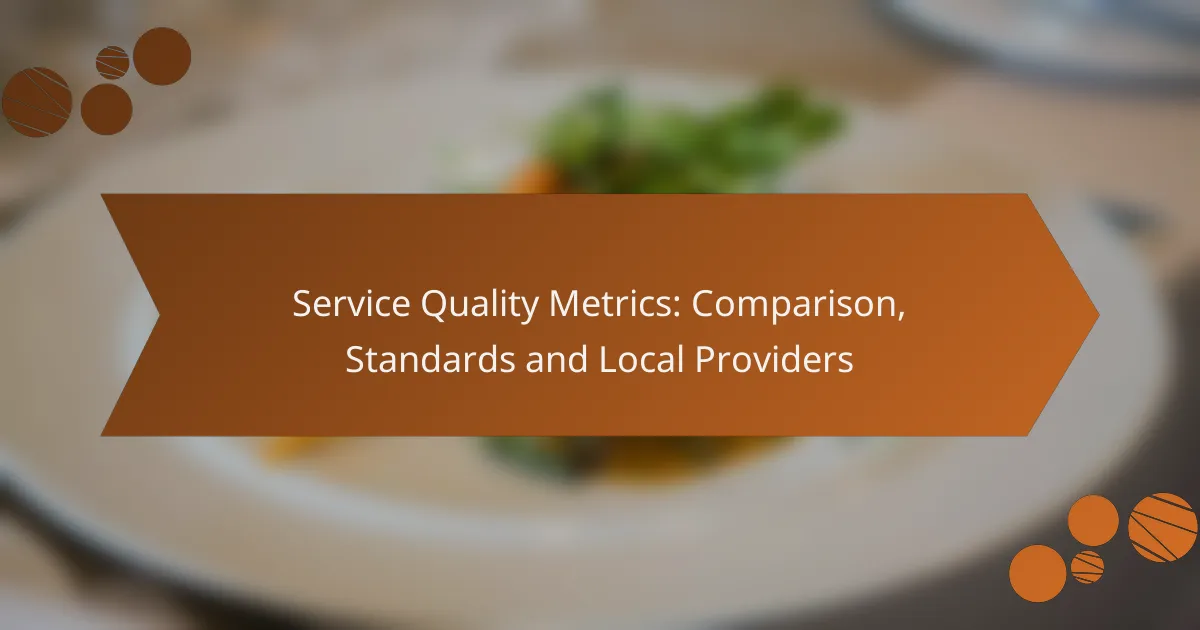Service quality metrics are essential for evaluating the performance of local providers, focusing on customer experience and operational efficiency. By comparing key indicators such as response time and resolution rate, businesses can identify areas for improvement and enhance customer satisfaction. Established standards and regulations play a crucial role in maintaining consistency and reliability in service delivery.

What are the key service quality metrics for local providers?
The key service quality metrics for local providers include various measures that assess customer experience and operational efficiency. Understanding these metrics helps businesses improve service delivery and meet customer expectations effectively.
Customer satisfaction score
The customer satisfaction score (CSAT) measures how satisfied customers are with a service or product. It is typically gathered through surveys asking customers to rate their experience on a scale, often from 1 to 5 or 1 to 10.
A high CSAT indicates that customers are pleased with the service, while a low score suggests areas needing improvement. Local providers should aim for scores above 80% to ensure a strong customer base.
Net promoter score
The net promoter score (NPS) assesses customer loyalty by asking how likely customers are to recommend a service to others. Responses are categorized into promoters, passives, and detractors, with the NPS calculated by subtracting the percentage of detractors from promoters.
A positive NPS indicates a healthy customer base and can range from -100 to +100. Local providers should strive for an NPS above 50 to demonstrate strong customer advocacy.
First response time
First response time measures how quickly a service provider acknowledges a customer inquiry or issue. This metric is crucial for customer satisfaction, as prompt responses can significantly enhance the overall experience.
Local providers should aim for first response times within a few minutes to a couple of hours, depending on the service type. Delays can lead to frustration and decreased customer loyalty.
Service level agreement compliance
Service level agreement (SLA) compliance tracks whether a provider meets the agreed-upon service standards, such as response times and resolution rates. This metric is essential for maintaining trust and accountability in customer relationships.
Local providers should regularly review SLA compliance to ensure they meet customer expectations. A compliance rate above 90% is often considered acceptable in many industries.
Resolution time
Resolution time measures how long it takes to resolve a customer issue from the moment it is reported. This metric is critical for understanding operational efficiency and customer satisfaction.
Local providers should aim for resolution times within a few hours to a couple of days, depending on the complexity of the issue. Quick resolutions can lead to higher customer retention and satisfaction rates.

How do service quality metrics compare across local providers?
Service quality metrics can vary significantly among local providers, impacting customer satisfaction and operational efficiency. Key metrics often include response time, resolution rate, and customer feedback, which help assess and compare the performance of different service providers.
Benchmarking against industry standards
Benchmarking against industry standards involves comparing a provider’s performance metrics with established norms within the sector. Common benchmarks include average response times of a few minutes and resolution rates above 80%. These standards help identify areas for improvement and ensure competitive service delivery.
Local providers should regularly assess their metrics against these benchmarks to remain relevant. For instance, a provider with a response time exceeding 10 minutes may need to enhance their support processes to meet industry expectations.
Comparative analysis of local service providers
Conducting a comparative analysis of local service providers involves evaluating their service quality metrics side by side. This can include analyzing customer satisfaction scores, service availability, and the effectiveness of communication channels. Such comparisons can reveal which providers excel in specific areas.
For example, if one provider consistently achieves higher customer satisfaction ratings while another has faster response times, customers may prioritize their choice based on specific needs. It’s crucial to consider not only the metrics but also the context in which they operate, such as local regulations and market conditions.

What standards govern service quality in local services?
Service quality in local services is primarily governed by established standards and regulations that ensure consistency and reliability. These standards help organizations maintain high levels of customer satisfaction and operational efficiency.
ISO 9001 certification
ISO 9001 certification is an internationally recognized standard that outlines the criteria for a quality management system. Organizations that achieve this certification demonstrate their ability to consistently provide products and services that meet customer and regulatory requirements.
To obtain ISO 9001 certification, companies must implement a quality management system that includes processes for continuous improvement and customer feedback. This often involves regular audits and assessments to ensure compliance with the standard.
Local regulatory compliance standards
Local regulatory compliance standards vary by region and industry, focusing on specific requirements that businesses must meet to operate legally. These standards can include health and safety regulations, environmental guidelines, and consumer protection laws.
For example, a local service provider in the European Union must adhere to the General Data Protection Regulation (GDPR) for data privacy. Understanding and complying with these local standards is crucial for avoiding penalties and ensuring customer trust.

How can local businesses improve their service quality metrics?
Local businesses can enhance their service quality metrics by actively seeking customer feedback and investing in staff training. These strategies help identify areas for improvement and ensure that employees are equipped to meet customer expectations effectively.
Implementing customer feedback systems
Establishing customer feedback systems allows businesses to gather insights directly from their clients. This can be done through surveys, suggestion boxes, or online reviews, which provide valuable data on customer satisfaction and service quality.
To implement an effective feedback system, consider using tools like online survey platforms or dedicated feedback apps. Aim for a response rate of at least 10-20% to ensure the data is representative. Regularly analyze the feedback to identify trends and areas needing improvement.
Training programs for staff
Training programs are essential for equipping staff with the skills needed to deliver high-quality service. These programs should focus on customer interaction, problem-solving, and product knowledge to enhance overall service delivery.
Consider offering both initial training for new hires and ongoing development for existing staff. A blend of classroom training, role-playing, and on-the-job coaching can be effective. Regular assessments can help ensure that staff members maintain high service standards and adapt to changing customer needs.

What are the prerequisites for measuring service quality?
Measuring service quality requires a clear understanding of objectives and effective data collection methods. These prerequisites ensure that the evaluation process is structured and yields actionable insights.
Defining clear service objectives
Establishing clear service objectives is crucial for measuring service quality effectively. Objectives should be specific, measurable, achievable, relevant, and time-bound (SMART). For example, a customer support team may aim to reduce response times to under five minutes within three months.
When defining objectives, consider the expectations of your target audience. This can involve gathering feedback through surveys or focus groups to understand what customers value most, such as promptness or personalized service.
Establishing data collection methods
Effective data collection methods are essential for accurately measuring service quality. Common approaches include surveys, interviews, and direct observation. Surveys can be distributed online or in-person, allowing for a broad range of customer feedback.
Choose methods that align with your objectives and resources. For instance, if you aim to assess customer satisfaction, a short online survey post-interaction may suffice. However, for in-depth insights, consider conducting interviews with selected customers.
![]()
What tools can assist in tracking service quality metrics?
Several tools can effectively track service quality metrics, helping businesses assess their performance and customer satisfaction. These tools provide valuable insights through data collection, analysis, and reporting, enabling organizations to make informed decisions.
Zendesk for customer support metrics
Zendesk is a popular platform for tracking customer support metrics, offering features that help businesses monitor response times, ticket resolution rates, and customer satisfaction scores. By utilizing Zendesk’s dashboard, teams can visualize performance trends and identify areas needing improvement.
Key metrics to focus on include first response time, average resolution time, and customer satisfaction ratings. For example, aiming for a first response time under 24 hours can enhance customer experience significantly.
SurveyMonkey for customer feedback
SurveyMonkey is an effective tool for gathering customer feedback, allowing businesses to create customized surveys to assess service quality. This platform enables organizations to collect insights on customer satisfaction, preferences, and areas for improvement.
When using SurveyMonkey, consider employing a mix of quantitative and qualitative questions to gain a comprehensive understanding of customer perceptions. Aiming for a response rate of around 20-30% can provide a solid sample size for analysis.
